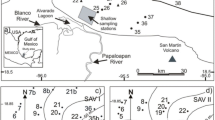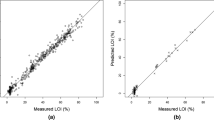Abstract
Purpose
The cost-efficient methods of analysis, such as rapid short-wave infrared (SWIR) spectral analysis, have been applied for the efficient exploration of critical raw materials (CRM), including mineral components and rare earth elements (REE) from the deep-ocean sediments.
Methods
Gravity cored sediment samples were collected during an oceanographic mission to the Trans-Atlantic Geotraverse (TAG) hydrothermal field of the Mid-Atlantic Ridge (MAR, 26° N). SWIR reflectance spectra (dependent variable) of samples were mathematically tested against referent geochemical data (independent variable), obtained by conventional analysis (ICP/OES, ICP/MS), after applied full cross-validation multivariate partial least square regression (CVPLSR). Value of parameter-residual predictive deviation (RPD) was used for evaluation of CVPLSR modeling: RPD > 2.5 (satisfactory calibration model for the screening purposes) and RPD > 5.0 (model adequate for the quality control of the studied elements).
Results
The CVPLSR modeling provided significant results for the determination of several mineral components: major elements (Fe and Si) had the values of RPD equal to 3.65 and 2.84, respectively, which indicated a viable potential for their routine analysis, whereas RPD for Ca was equal to 5.51, thus assuring its quality control by SWIR analysis, in sediment samples of the studied location. Among the REE, Ce (RPD = 2.55) and Er (RPD = 2.59) yielded the most satisfactory results.
Conclusions
The findings highlight the benefit of rapidly obtained empirical SWIR-reflectance data, which can be used for near-real-time exploration of geochemical deposits hosted in deep-ocean sediments.








Similar content being viewed by others

References
Actlabs (2019) Euro schedule of services, http://www.actlabs.com/. Accessed 07 April 2019
Barriga FJAS (2017) Can recycling and the circular economy render seafloor mining unnecessary? Economical, technological and environmental aspects: cooperative solutions for future deep-sea mining underwater mining conference, Federation of German Industries (BDI). Germany, Berlin
Blengini GA, Nuss P, Dewulf J, Nita V, Talens Peiro LT, Vidal-Legaz B, Latunussa C, Mancini L, Blagoeva D, Pennington D, Pellegrini M, Van Maercke A, Solar S, Grohol M, Ciupagea C (2017) EU methodology for critical raw materials assessment: policy needs and proposed solutions for incremental improvements. Resour Policy 53:12–19
Campbell AC, Palmer MR, Klinkhammer GP, Bowers TS, Edmond JM, Lawrence JR, Casey JF, Thompson G, Humphris S, Rona P, Karson JA (1988) Chemistry of hot springs on the Mid-Atlantic Ridge. Nature 335:514–519
Carvalho CMN, Barriga FJAS (2000) Preliminary report on the mineralogical detailed study at the alterations zones surrounding the Feitais VMS ore body (Aljustrel, Portugal, IPB), in: Proceedings International Conference and Field Meeting on Volcanic environments and Massive Sulfide Deposits, CODES Special Publication, 3:19–21
Christie T, Brathwaite B, Tulloch A (1998) Mineral commodities report 17 - rare earths and related elements. New Zealand Institute of Geological and Nuclear Sciences Limited pp. 1–13
Clark RN, King TVV, Klejwa M, Swayze GA (1990) High spectral resolution reflectance spectroscopy of minerals. J Geophys Res 95:12653–12680
Coulomb R, Dietz S, Godunova M, Nielsen TB (2015) Critical minerals today and in 2030: an analysis for OECD countries. OECD environment working papers, OECD Publishing, Paris, no 91:1–50
Elderfield H, Hawkesworth CJ, Greaves MJ, Calvert SE (1981) Rare earth element geochemistry of oceanic ferromanganese nodules and associated sediments. Geochim Cosmochim Acta 45:513–528
Emsbo P, McLaughlin PI, Breit GN, du Bray EA, Koenig AE (2015) Rare earth elements in sedimentary phosphate deposits: solution to the global REE crisis? Gondwana Res 27:776–785
European Commission (2017) Study on the review of the list of critical raw materials, Executive summary report. DG for Internal Market, Industry, Entrepreneurship and SMEs, Brussels, Sep. pp. 1–9
Gaffey SJ (1986) Spectral reflectance of carbonate minerals in the visible and near infrared (0.35-2.55 microns); calcite, aragonite, and dolomite. Am Mineral 71:151–162
German CR, Klinkhammer GP, Edmond JM, Mura A, Elderfield H (1990) Hydrothermal scavenging of rare-earth elements in the ocean. Nature 345:516–518
German CR, Higgs NC, Thomson J, Mills R, Elderfield H, Blusztajn J, Fleer AP, Bacon MP (1993) A geochemical study of metalliferous sediment from the TAG hydrothermal mound, 26°08’N, Mid-Atlantic Ridge. J Geophys Res 98:9683–9692
Giese EC (2018) Rare earth elements: therapeutic and diagnostic applications in modern medicine. Clin Med Rep 2:1–2
Hein JR, Mizell K, Koschinsky A, Conrad TA (2013) Deep-ocean mineral deposits as a source of critical metals for high- and green-technology applications: comparison with land-based resources. Ore Geol Rev 51:1–14
Horsfall C (1999) Short wave infrared spectroscopy for geological mapping and mineral exploration using the PIMA field portable spectrometer. PIMA SP and PimaView 3.1 Integrated Spectronics (6th ed) Pty Ltd. North Ryde NSW, 2113, Australia, pp. 1–77
Integrated Spectronics (1999) Short wave infrared spectroscopy for geological mapping and mineral exploration using the Pima field portable spectrometer 6th edition of Pima SP and Pima View User Manual, Baulkam Hills, p 72
Kerr A, Rafuse H, Sparkes G, Hinchey J, Sandeman H (2011) Visible/infrared spectroscopy (VIRS) as a research tool in economic geology: background and pilot studies from Newfoundland and Labrador. Current Research, Geological Survey Report 11:145–166
Kleinebecker T, Poelen MDM, Smolders AJP, Lamers LPM, Hölzel N (2013) Fast and inexpensive detection of total and extractable element concentrations in aquatic sediments using near-infrared reflectance spectroscopy (NIRS). PLoS One 8:e70517
Koeppenkastrop D, De Carlo EH (1992) Sorption of rare-earth elements from seawater onto synthetic mineral particles: an experimental approach. Chem Geol 95:251–263
Lorenz S, Beyer J, Fuchs M, Seidel P, Turner D, Heitmann J, Gloaguen R (2019) The potential of reflectance and laser induced luminescence spectroscopy for near-field rare earth element detection in mineral exploration. Remote Sens 11:21
Lusty PAJ, Murton BJ (2018) Deep-ocean mineral deposits: metal resources and windows into earth processes. Elements 14:301–306
Milinovic J, Dias ÁA, Janeiro AI, Pereira MFC, Martins S, Petersen S, Barriga FJAS (2020) XRD identification of ore minerals during cruises: refinement of extraction procedure with sodium acetate buffer. Minerals 10:160
Mills R, Elderfield H, Thomson J (1993) A dual origin for the hydrothermal component in a metalliferous sediment core from the Mid-Atlantic Ridge. J Geophys Res 98:9671–9681
Murton BJ, Berit L, Dutrieux AM, Martins S, de la Iglesia AG, Stobbs IJ, Barriga FJAS, Bialas J, Dannowski A, Vardy ME, North LJ, Yeo IALM, Lusty PAL, Petersen S (2019) Geological fate of seafloor massive sulphides at the TAG hydrothermal field (Mid-Atlantic Ridge). Ore Geol Rev 14:903–925
Petersen S (2016) News from the seabed - geological characteristics and resource potential of deep-sea mineral resources. Mar Policy 70:175–187
Petersen S (2017) Metal fluxes and resource potential at the slow-spreading TAG mid-ocean ridge segment (26°N, MAR) – Blue Mining @ Sea, Cruise No. M127, Bridgetown (Barbados) - Ponta Delgada (Portugal), May 25–June 28, 2016. RV METEOR, Cruise report M127 (extended version), GEOMAR pp. 1–59
Petersen S, Yeo I, Jamieson J, Szitkar F, Graber S, Augustin N, Rothenbeck M, RV Meteor Scientific Part (2017) AUV-based exploration of the TAG segment at 26°N, Mid-Atlantic ridge: implications for resource assessment and metal fluxes. Goldschmidt Abstracts, Paris, France, 3135
Rona PA, Klinkhammer G, Nelsen JA, Trefry JH, Elderfield H (1986) Black smokers, massive sulphides and vent biota at the Mid-Atlantic Ridge. Nature 321:33–37
Rona PA, Petersen S, Becker K, Von Herzen RP, Hannington MD, Herzig PM, Naka J, Lalou C, Thompson G (1996) Heat flow and mineralogy of TAG relict high-temperature hydrothermal zones: Mid-Atlantic Ridge 26ºN, 45ºW. Geophys Res Lett 23:3507–3510
Sun Y, Seccombe K, Yang K (2001) Application of short-wave infrared spectroscopy to define alteration zones associated with the Elura zinc-lead-silver deposit, NSW, Australia. J Geochem Explor 73:11–26
Thompson G, Mottl MJ, Rona PA (1985) Morphology, mineralogy and chemistry of hydrothermal deposits from the TAG area, 26°N Mid-Atlantic Ridge. Chem Geol 49:243–257
Thompson AJB, Hauff PL, Robitaille AJ (1999) Alteration mapping in exploration: application of short-wave infrared (SWIR) spectroscopy. SEG Newsletter 39:16–27
Turner DJ, Rivard B, Groat LA (2014) Visible and short-wave infrared reflectance spectroscopy of REE fluorocarbonates. Am Mineral 99:1335–1346
Turner DJ, Rivard B, Groat LA (2016) Visible and short-wave infrared reflectance spectroscopy of REE phosphate minerals. Am Mineral 101:2264–2278
Van Dover CL (2019) Inactive sulfide ecosystems in the deep sea: a review. Front Mar Sci 6. https://doi.org/10.3389/fmars.2019.00461
van Ruitenbeek FJA, Cudahy TJ, Van der Meer FD, Hale M (2012) Characterization of the hydrothermal systems associated with Archean VMS-mineralization at Panorama, Western Australia, using hyperspectral, geochemical and geothermometric data. Ore Geol Rev 45:33–46
Williams PC, Sobering DC (1993) Comparison of commercial near infrared transmittance and reflectance instruments for analysis of whole grains and seeds. J Near Infrared Spec 1:25–32
Acknowledgments
The work was done as part of the project “BLUE MINING—Breakthrough solutions for the sustainable exploration and extraction of deep-sea mineral resources,” that has received funding from the European Union’s Seventh Framework Programme for research, technological development, and demonstration under grant agreement no. 604500. The authors would like to acknowledge the financial support FCT through project UIDB/50019/2020–IDL.
The authors would like to thank Dr. Sven Petersen (GEOMAR, Helmholtz Center for Ocean Research, Kiel, Germany), Dr. Sofia Martins, and the “M127” cruise team, for their technical support during the oceanographic mission and gravity core recovery, for their preservation a priori analysis, and for the AUV-derived map of the TAG hydrothermal field.
The authors are specially thankful to Editor-in-Chief of the Journal, the Subject Editor, and the Referees for their constructive and valuable comments, which improved the manuscript until its final version.
Author information
Authors and Affiliations
Corresponding author
Ethics declarations
Conflict of interest
The authors declare that they have no conflicts of interest.
Ethics statement
The research did not involve any studies with human participants and/or animals. Informed consent was obtained from all individual participants included in the study.
Additional information
Responsible editor: Patrick Byrne
Publisher’s note
Springer Nature remains neutral with regard to jurisdictional claims in published maps and institutional affiliations.
Rights and permissions
About this article
Cite this article
Milinovic, J., Barriga, F.J. & Murton, B.J. Analysis of deep-ocean sediments from the TAG hydrothermal field (MAR, 26° N): application of short-wave infrared reflectance (SWIR) spectra for offshore geochemical exploration. J Soils Sediments 20, 3472–3486 (2020). https://doi.org/10.1007/s11368-020-02691-3
Received:
Accepted:
Published:
Issue Date:
DOI: https://doi.org/10.1007/s11368-020-02691-3



